Part 1: Episode I: Psilons, 1st Attempt
EPISODE IPsilons, 1st Attempt
I'll go through various game screens and aspects to explain how everything works in this first game; in later games/episodes I'll be a lot quicker to get to the action, and individual updates will tend to be shorter.
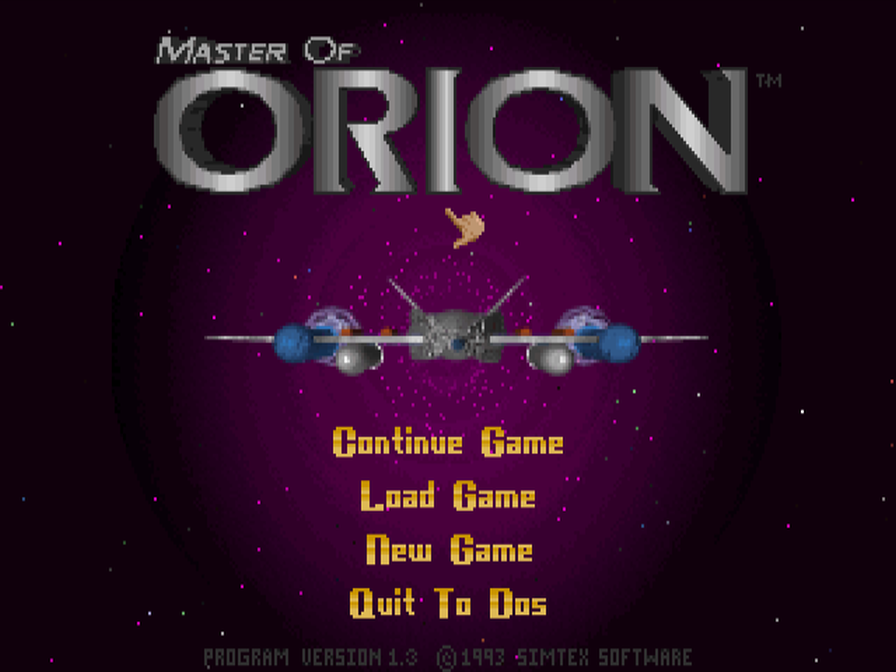
Here we have the ubiquitous title screen. What you can't see here is that there is some basic animation; the engines spin and the purplish particles are continuously being sucked into the vortex in the background. 'Quit to DOS' tells you exactly how ancient this game is.
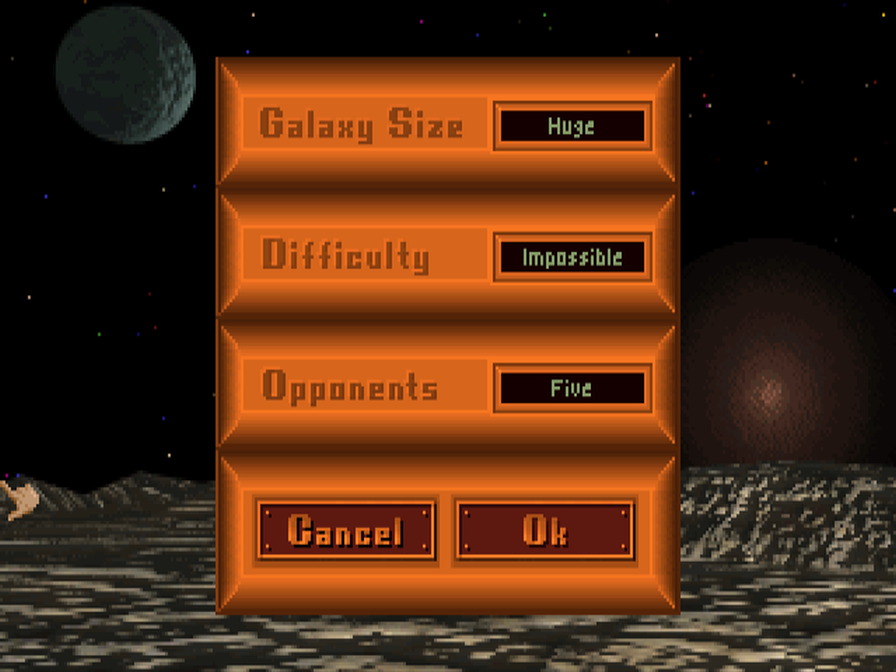
Upon beginning a new game, we are taken here, an options screen which is simplicity itself. One thing I appreciate here is that it defaults to the last settings you used; we'll see this in other places as well. So very many games made after this didn't do this.
** Galaxy Size: Small(24 stars), Medium(48 stars), Large(70 stars), or Huge(108 stars). Pacing is quite different between them, so to show them off I'll start out on Small and work my way up. Large is my preferred setting as a balance between pacing and getting to most of the technology in the course of a game, so once we've seen them all once the rest of the games will be played at that size. The manual says small is the hardest size; there's an argument to made for that but I don't happen to necessarily agree; I'd say rather that the the smaller sizes are more double-edged in my experience.
** Difficulty: Simple/Easy/Average/Hard/Impossible. The AI gets major production and technology handicaps on the lower difficulties and bonuses on the higher ones: 20% for Easy/Hard and 40% for Simple/Impossible IIRC. Their starting fleet size, aggressiveness, etc. are also impacted. Choosing Hard or Impossible also gives the player a 20% penalty in starting population, which has a bigger impact than you might think. I'll be playing exclusively on Impossible.
** Opponents: One through Five here. Five will always be our setting. The game is a lot less interesting with a low number of opponents. Even at the max, almost half of the races will be unrepresented in any given game.
So our initial foray here is set at Small/Impossible/Five.

Then we choose our race from the ten options, Psilons as mentioned. The small pixellated portraits here are rather unimpressive. After picking the Psilons, we choose the color of our banner/flag:
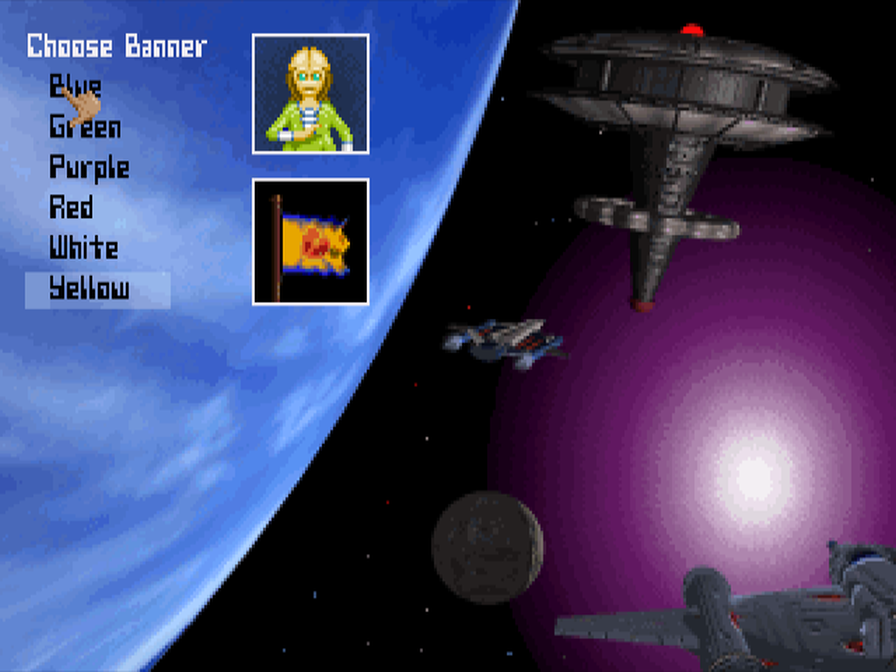
Not at all obvious, though it is mentioned in the manual, is the fact that this choice will also determine our ship models for the game. The Psilons are yellowish in appearance, so yellow it is. We'll see all of them at least once before this (mis)adventure is completed.
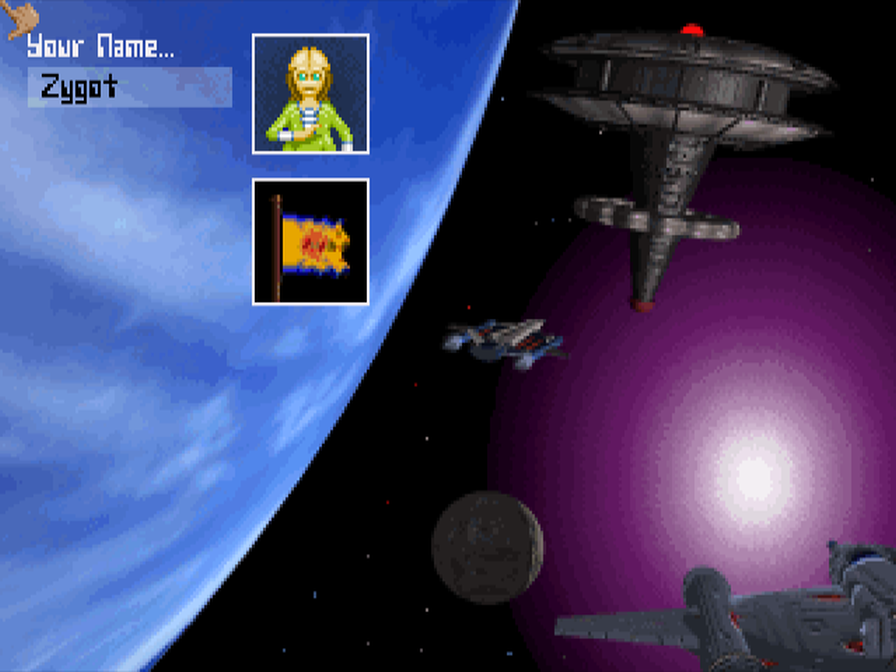
Finally, there's prompt to select a name for ourselves as Emperor, and our homeworld, or to leave them at the default. Homeworld always defaults to the same name for each race, and there are a few rotating emperor names. I leave them at the suggested names, and hereby will be referred to for all antiquity as Emperor Zygot of the planet Mentar.
And with that, our journey begins.
OPENING, PART I
A properly played game of Master of Orion has a clearly definable opening stage. Normally I'd put all of it into one update, but with the amount of necessary exposition here I'm going to break it up. Our goals here are as follows:
** Scout as far as possible
** Establish a second planet/first colony.
** Build up our homeworld's industrial base ASAP.
The core concept of maximizing the growth curve will be quite familiar to any fan of 4X-style games. When it comes to this, the compounding effect of decisions means that the first ones are the most important; they will impact everything that comes after. Doing the first few turns 'correctly' provides for the maximum amount of resources being available later on, etc.
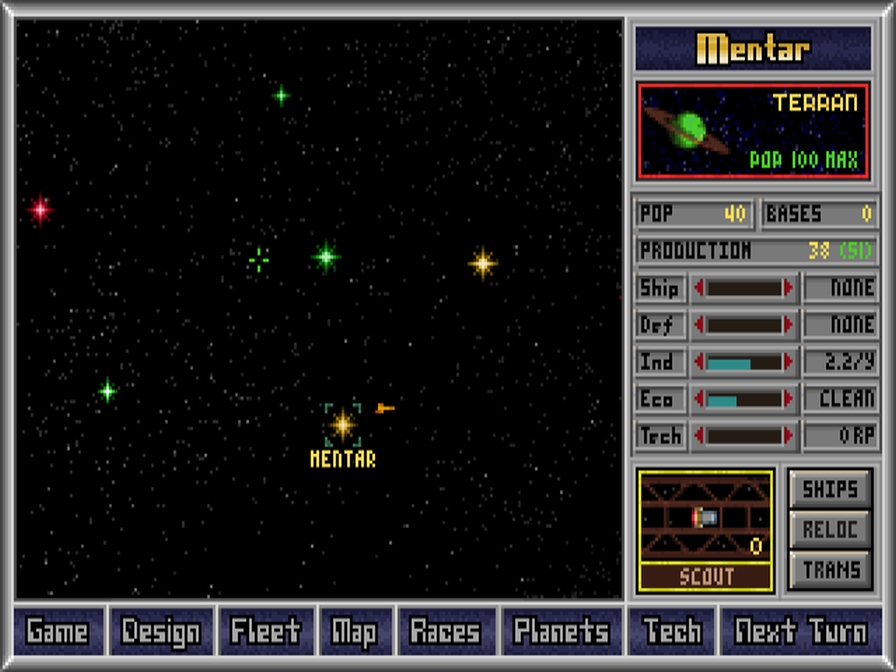
This is the first view to greet us, known as the Control Screen. The majority of it is just the galaxy view, and is quite self-explanatory; click on a planet or fleet for more information. That info is displayed on the panel on the right, with the menu button row on the bottom.
Star Colors: We can see a few different-colored stars right now, and there are more. The colors don't matter once a system has been explored, but before that they gives us a general indicator of what we are most likely to find there. They come in six varieties, as follows:
Yellow -- "offers the best chance of finding terran and sub-terran planets". By terran and sub-terran, this means simply standard, i.e. habitable at game start without specialized abilities or technology, planets.
Green -- "moderately bright and have a wide range of planet types"
Red -- "Old, dull stars that commonly have poor planets". Poor meaning mineral poor, which we will get to in a moment.
Blue -- "Relatively young stars with mineral rich lifeless planets".
White -- "Burn incredibly hot and generally have hostile planets"
Purple -- "Neutron stars are rare and offer the greatest chance of finding rich planets."
I'll explain in a bit what the heck all this rich/poor/lifeless/hostile/terran/standard etc. stuff really means, but first let's take a long at the details for our homeworld on the right-side panel.
From top to bottom, we can see that it is Terran with a 100-max population; that's the best class of planet there is, and your homeworld always starts out as 100 max. The possible range of planetary populations ranges from 10 to 120 initially, so it's very good but not perfect. Below that we have current population of 40(50 on Average difficulty or below), 0 bases(missile bases, to be discussed more at a later time), and then production says 38(51). The first number is actual production after all current costs are taken out; second number is total production. The five sliders below that control planetary spending, the 38 available to us, as we see fit. Production in MOO is equal to one-half of the current population plus the current number of factories. You always start with 30 factories, so 40 population divided by 2 = 20, +30 factories = 50 production.
The five spending categories are fairly self-explanatory.
Ship = Shipbuilding
Defense = Planetary Shields and Missile Bases; i.e. static planetary defenses
Industry = Building factories increases the industrial base
Ecology = Factories also produce waste; that's cleaned up here at an initial rate of 2 waste removed per BC. Any extra goes to terraforming if we have the tech(we don't right now), or to increasing population growth
Tech = Researching new technologies
Below that we can select what ship to build by clicking the image or the Ship button. RELOC is a rally-point concept; any ships built at one system can be re-routed automatically somewhere else. This is of course pointless at the moment with only one planet, since we have to send them somewhere that is under our control. TRANS allows sending up to half the population per year to another system, for bolstering other colonies or ground invasions.
Next we need to understand that star/planet type stuff, so we'll head to the Map menu button in the bottom row.
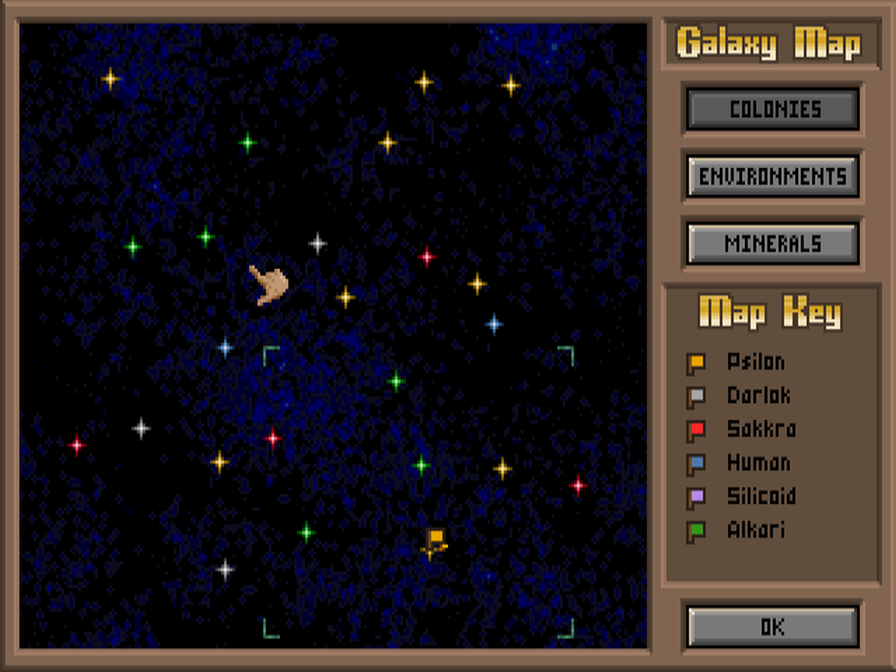
At the top of the right-side panel you can see three buttons, defaulting to 'Colonies'. These are basically map modes long before map modes became a thing. The Map Key below tells us who we are up against, which is important information although you never know how things are going to shake out. I'm not sad to see there are no Klackons, but the Silicoids and Humans aren't likely to be fun. Darlok, Sakkra, Alkari -- the draw could be worse and it could be better. Only one system has a flag; our homeworld, since we know nothing about the rest of the galaxy. We can guess at the location of the other empires though; they will always start at yellow stars. The one above and to the right of us right by the 'hand cursor' is too close I think; one advantage the player has is a 'safe zone' around their homeworld. If the upper-left is an AI they'll be screwed with no other nearby stars, probably one or two in the upper-right. That one in the lower left and the one right smack dab in the middle are almost certainly homeworld locations. But we can't really know for sure yet. One thing to keep in mind with a small galaxy is that along with being smaller, it's the least dense; stars are more closely packed together in the bigger ones.
The other two views bring up the stuff I was talking about relating to different star types. Each star system's potential is represented by a single planet, or none at all; there's no moons or multiple planets to be concerned with here. Behold the Environments display:
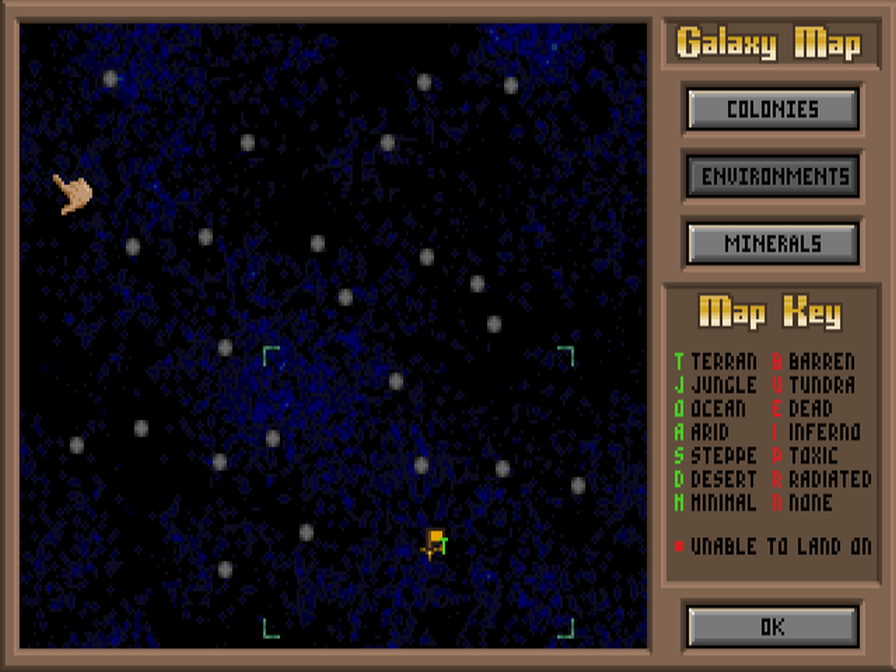
Now the Map Key displays the varying types of planets in the game. If you look closely, you'll see a corresponding green T by our homeworld of Mentar on the starmap. The two columns represent the two basic types, in terms of habitability: standard and hostile. As you go down each list(i.e, terran through minimal on the left, barren through none on the right), the maximum population of each planet type decreases. There is some randomness; a big jungle planet is better than a small terran, for example, but in general most terrans will be larger. Larger is always better in this case, and in most things in Master of Orion. The hostile planets are nthose more likely to appear in the blue, white, and purple stars we talked about earlier, and for our purposes at the moment there are two important facts about them. First, we can't colonize them with researching the appropriate technologies. Secondly, population growth is halved on those worlds once we can. This means that half of the planet types can only be settled by Silicoids to start things off, allowing them to develop worlds the rest of us can only gaze at. Hostile planets do tend to be smaller as well.
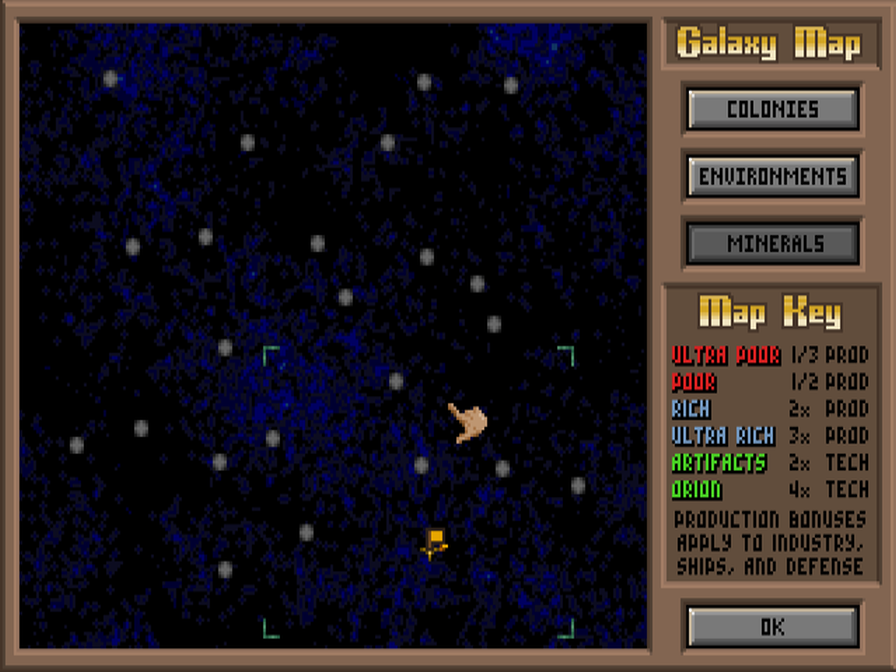
Finally, the Minerals view shows anything special about a planet's production. Again from the map key, Ultra Poor, Poor, Rich, and Ultra Rich have the effect of negative or positive multipliers on a planet's production. Note that these apply to industry, ships, and defense; ecology and technology are unaffected. In other words, you can't build crap without mineral resources, which these specials modify. The two types listed in green also require explanation. Artifacts planets are distinctive for a couple of reasons. They are planets where the mysterious 'Masters' have left remnants of their civilization, and study of those ruins doubles all tech output from these planets. Also, the first empire to scout an artifact planet receives a bonus tech advance from initial survey of these ruins. Orion is unique, as the manual intro I previously quoted indicates. The massive research quadrupling that occurs there is only one part of that unique status. Note that each planet can only have one 'mineral special'; that is, you'll never see a Poor Artifacts planet, or whatever.
The assessment of a planet and it's economic value then, comes from a combination of three factors: maximum population, environment, and the speciality or lack thereof.
Back at the main Control screen, it's time to take a look at our current fleet, such as it is.
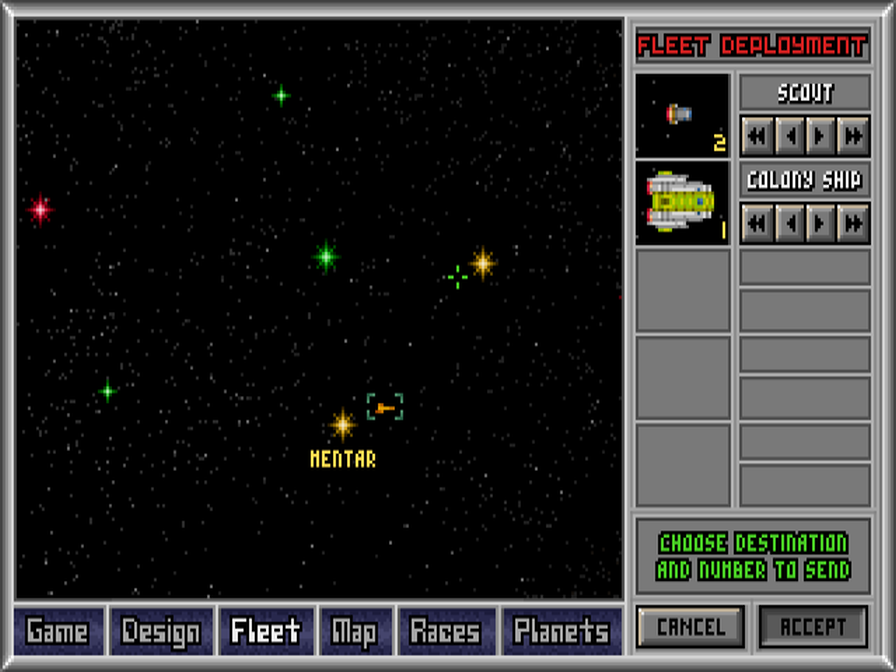
On the left the fleet has been selected, and the right panel again shows us what's there. We'll get into more detail on ships and fleets and whatnot later, but for now we can easily see a pair of scouts and a single colony ship. These do pretty much what you'd expect them to do. Any ship can serve as a scout; what makes these special is they have reserve fuel tanks, which allow an extra 3 parsecs of range. Default game-start technology provides a 3-parsec range, so our scouts have double the range of our colony ship. They all also have retro engines, allowing basic warp travel; 1 parsec per year. We won't get anywhere in a hurry.
There's one final thing to understand before we decide what actions to take. The Planets button is our next place to visit.
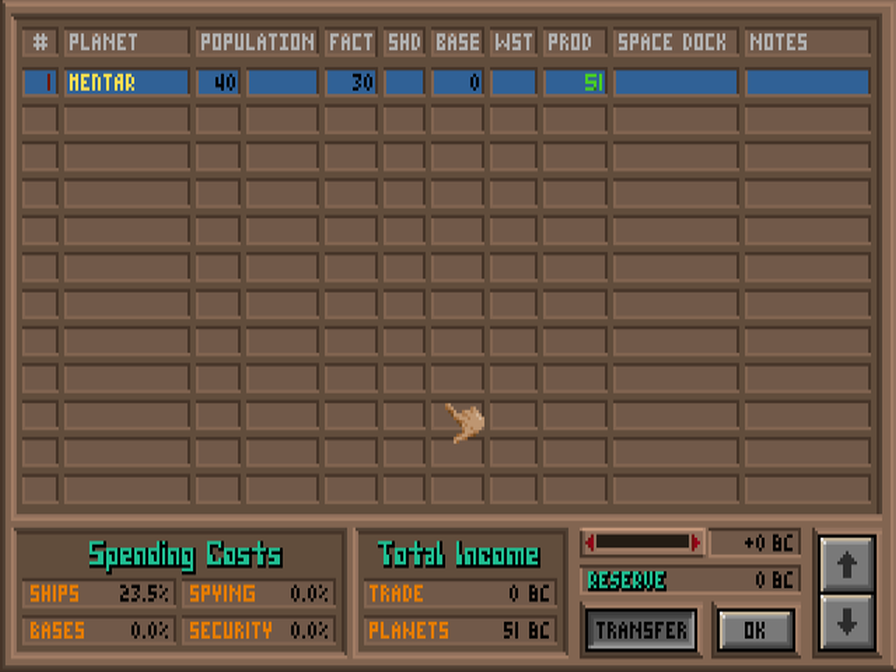
Most of this is your basic ledger/spreadsheet with important info on all of our planets, but right now we're most concerned with some very important stuff at the bottom. Remember what I said about actual versus total production? This is where you find out what the 'missing' amount is going to. On the bottom we've got ships, bases, spying, security, trade income, etc. Now spying and security aren't a thing because we haven't met the other races yet of course, but that 23.5% in the ships category really sticks out like a sore thumb. We're spending almost a quarter of our production maintaining the fleet -- and it's all going to that monstrosity of a colony ship, which(we'll see where to find this information later) costs 591 BC to produce, or almost a dozen years of production. Yikes.
ProTip: Due to this maintenance cost for the colony ship, getting that first colony going ASAP is huge in terms of maximizing the growth curve. Getting rid of that much overhead at this point in the game is absolutely vital.
So, let's take a look at what's within range. It turns out that, as happens fairly often in small galaxies, the decision was made quite simple for us. There is only one, the green star directly above us, three parsecs away. The yellow one to the right of it is four parsecs, the green one to our left is five, and everything else is further out.
If that system isn't habitable, we're really in a bind -- but while it is possible to have no systems at all within colonizable range, though quite rare, when there is one they are hardcoded to be habitable AFAIK(at least one at any rate). I've never found a contrary example. One potentially tough choice is made self-evident and off the colony ship goes. The two scouts will head to the green and red stars beyond that one(above and above/left). Their goal is to push as far into the galaxy as possible.
ProTip: AI Races are much less likely to try and settle a system that they have to fight for. Stationing a mere scout in a system can dissuade them, at least for a time. If they really want/need it they are coming anyway, but 'picketing' by stationing scouts everywhere within their travel range can slow their advance, sometimes significantly. It's crucial to restrict them at the same time you are expanding your own holdings.
So we've got the glorious Psilon Fleet dispatched, which collectively has not a single weapon, shield, or electronics system beyond the basics onboard. They have what they need to complete their missions, and nothing else. Our final decision before we can actually advance to the next year: what do we invest in on Mentar?
Defense is out, as we have no need for it prior to first contact. Technology is always vital but right now we have what we need to expand which is the top priority. Ecology requires 16 of our available 38 production(that's 42% for those of you scoring at home) just to keep things clean; putting more could help increase population but that would be highly inefficient. With starting technology, it requires a 20 BC investment to grow another 1M population; factories cost half as much(10 BC) and provide double the benefit. Each million(pop represents 1 million workers) can operate two factories each, so there is a limit; but we currently only have 30 factories for 40M pop, so we are not even halfway to that limit. And of course population will grow on it's own, factories don't.
The choice comes down to two: factories or more scouts. There's no way to be absolutely certain which one will be better. The growth curve being all-important suggests building that industry with maximum haste, but that means delaying scouting some star systems -- systems our rivals could reach before we do as a result. Even among players capable of competing with the AI on Impossible there is not a clear consensus here, which is one of the things I love about this game; right from the start there is nuance and decision-making with no self-evident choice.
My approach is to basically split the difference here; invest in factories for a few turns, typically until the first colony is established, then with the slightly improved economic base and less overhead, I'll pump out the needed scouts, after which I'll return to factory investment. Our remaining 22 BC(not bitcoin, that's Billion Credits, our currency) will allow for 2.2 factories this year(the game does track to one decimal place).
There's not much else to say really. For Mentar!!
When you click 'Next Turn' to advance the game, the Galaxy Map will display briefly and you can see ship movement within sensor range. Right now we can see nothing but our own ships, as our sensor range is ... lacking. I think it starts at 3 parsecs from colonies, 1 from ships. Might not even be that good.
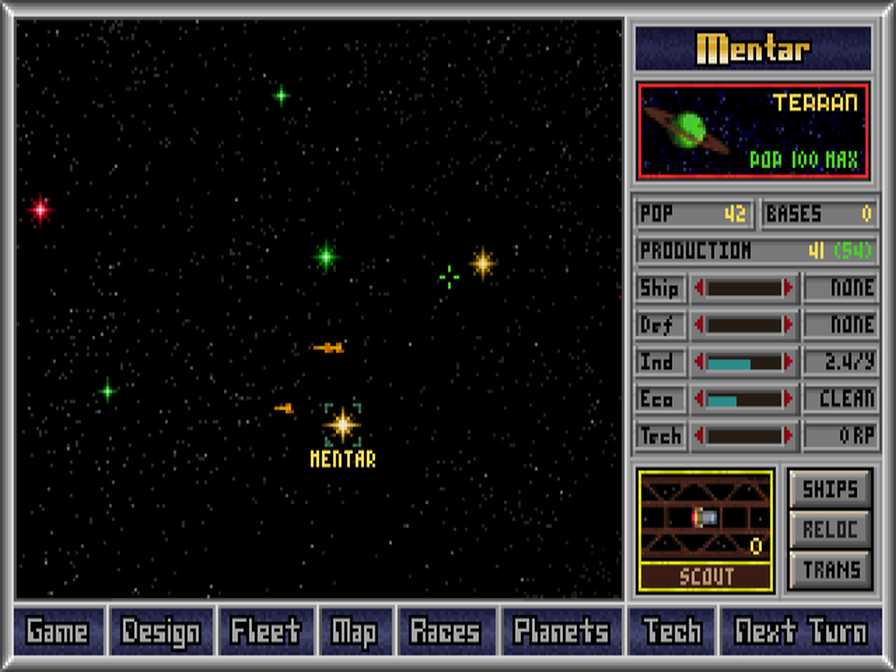
Here's how things look after our orders are resolved. We've advanced to turn 2, aka 2301, one year per turn in Master of Orion. Population has grown a couple to 42M, we've built factories and are up to 2.4/year, production up from 38(51) to 41(54). Also, the ships have moved off in their various directions. They all appear to be 'pointing' to the left; you can get an idea on where a fleet is heading this way as well, although it'll only indicate left/right. The between-turn method is the only way to know more(unless it's our ships, in which case just selecting it will tell you where and how long). Also worth noting is that we can't change our minds now on where to send them. Until technology allows it, we can only communicate with them at star systems. That means you want to be sure before you send ships somewhere, esp. if they are going to take a long time to get there.
Not much to do at this point but wait for them to arrive and keep building factories on Mentar.
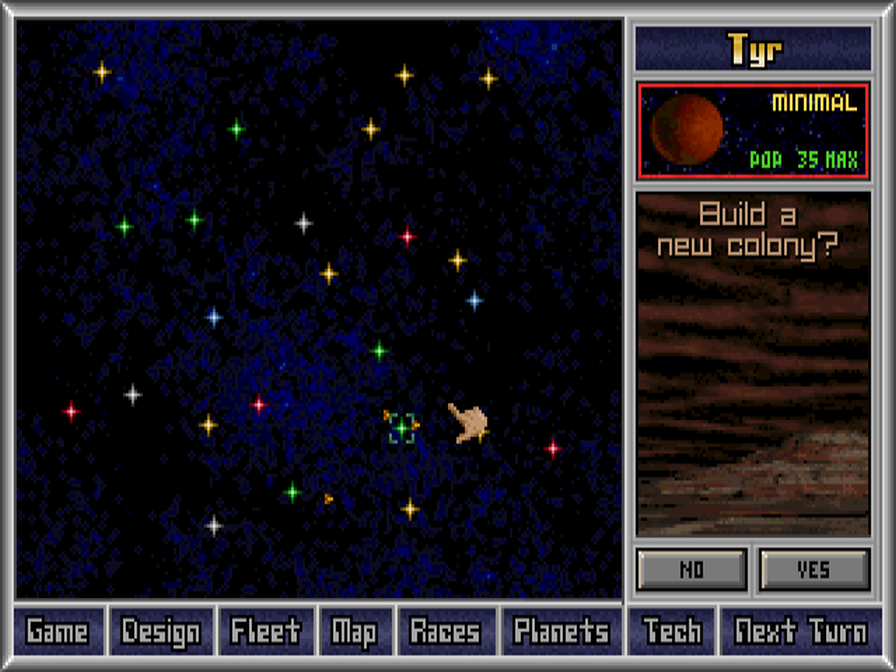
A couple of years later, we have news of the not-great variety. Our target system above Mentar is named Tyr, and Minimal(35 max.) is pretty crappy. It's not terrible news; no enemies and we can colonize it, but at only a third the size of Mentar it sucks. There being no alternatives in range though it's not even a decision.
After selecting YES to the colonization prompt, we're treated to a landing video which can be skipped but plays every time you colonize a system. This is our sole opportunity to rename the system if we choose; I tend to stick with the default names.
https://www.youtube.com/watch?v=eMJcp8vzpag
There is some blurriness there compared to the ingame, as you'll notice if you compare to the screenshots. I think that's due to the DOSBOX video capture feature, which as far as I know is my only option. If anyone has any suggestions on improving it though let me know.
Let's take a look at Tyr now and see what we have to work with.

This display is accessible in two ways; clicking on the star itself a second time, or on the red box at the top of the right-side panel that has the name, class, population etc. I prefer the Planets screen since it has information on all of them at once for comparison, and doesn't take any more work to get to, but it was worth showing. You can't interact with anything on this screen, but it does have icons in the lower left for those who prefer a visual representation. The one right now is for population(1 per 10), and there are others for factories and bases if appropriate.
All new colonies start out with no factories at all, and a population of a whopping 2M. If you remember our production calculations earlier, that means 1BC is all we'll produce here; at that rate it would take a decade just to build a factory. We'll want to transfer in some population from Mentar to speed things up. Let's see how the homeworld is faring ...
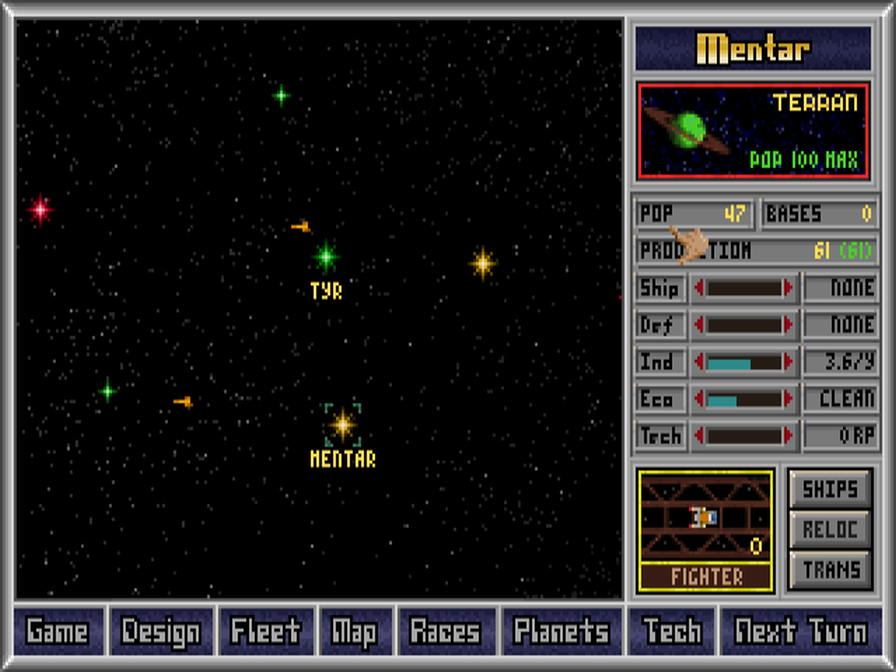
Production is now set free here, at 61(61). That's because we are no longer paying for that colony ship. The two scouts continue on their way, but their maintenance is negligible. In the last three years seven factories have been built on the homeworld, but we can now build them much faster.
ProTip: Whenever you have a major change in your automatic spending(i.e., the amount that comes out of your production due to ship maintenance, etc.) it's always a good idea to revisit your planetary sliders. They will remain at the same ratio, but since the amount you have to spend will have changed, you'll still end up with different results and will probably want to make adjustments. Ecology is what I look at first since often you want the minimum amount to clean up all the waste and you'll either end up with not enough to do that, or too much which isn't efficient. In this case, we don't need this much going into ecology anymore; part of our production increase is just going to be wasted that way.
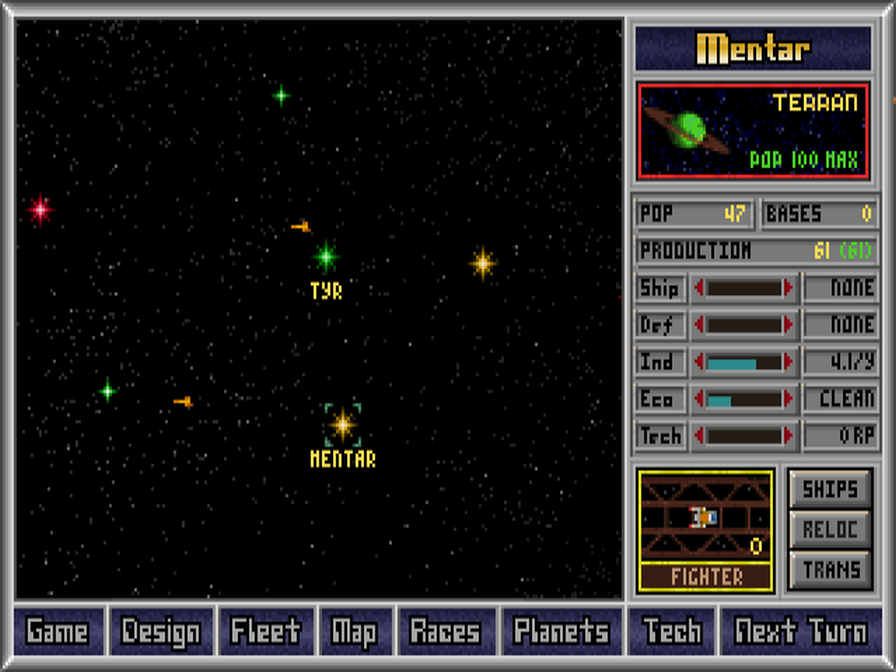
There, that's better. 20 of the 61 is now going into waste cleanup: our 37 factories are producting about 40 units of waste. But there's more to do here. I want to transfer some population to Tyr to boost that planet, without hamstringing Mentar too much. Transports move at one parsec slower than your best engine tech typically, although right now both are at one parsec since that's the minimum. It'll take everyone we send three years to reach Tyr, and in the meantime they won't produce anything. The maximum allowable transfer is half of the current population on the source planet, but we aren't going to send anywhere near that much.
ProTip: When making these kinds of decisions it's important to keep in mind how population growth works. It's basically a bell curve; planets grow fastest at half of their max population. Below a third or above two-thirds it slows down considerably, so keeping things in that 'middle third' is optimal where growth is concerned.
Mentar isn't anywhere close to the amount of factories it's population needs to operate yet, so losing a little population isn't going to hurt it. At 47 out of 100M max, it's not to the 'sweet spot' of halfway yet either though. To keep overall growth as high as possible, I'll send as many new colonists as Tyr needs, keeping Mentar at least at 50M. For now, we'll only send 1M per year until it reaches that halfway point; that way we'll aid the growth of Tyr a bit, but Mentar will still be growing.
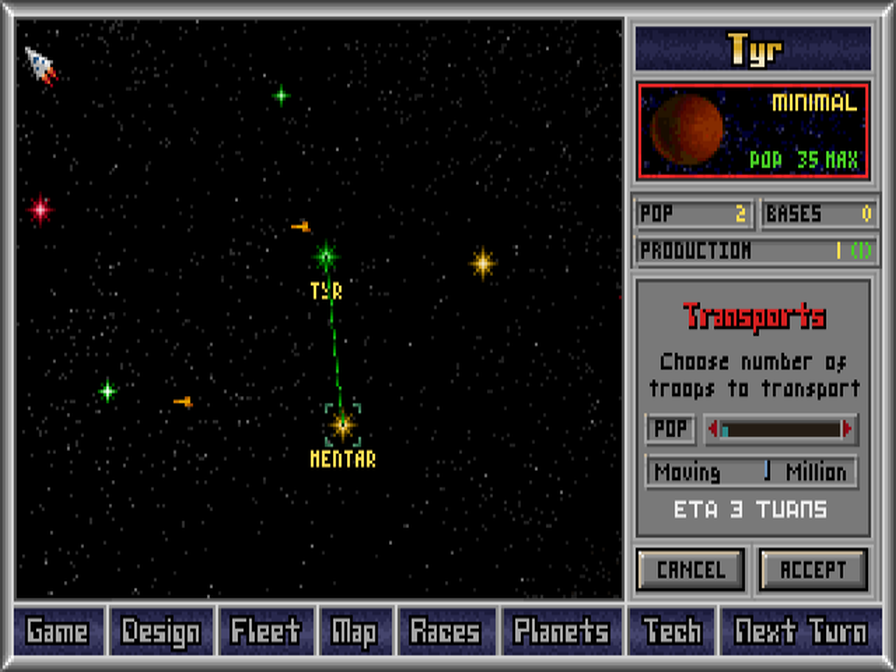
After selecting TRANS and clicking on the destination system, we get a line showing the path to be followed, and an ETA. The path will be similarly shown for any RELOC operations, which we will certainly be using at some point.
That's everything we can do right now to boost Tyr, which will put it's miniscule production into factory-building as well.
This seemed as good a place as any to put in a break. Next time I'll conclude the opening with a lot more game-years being covered and somewhat less exposition.